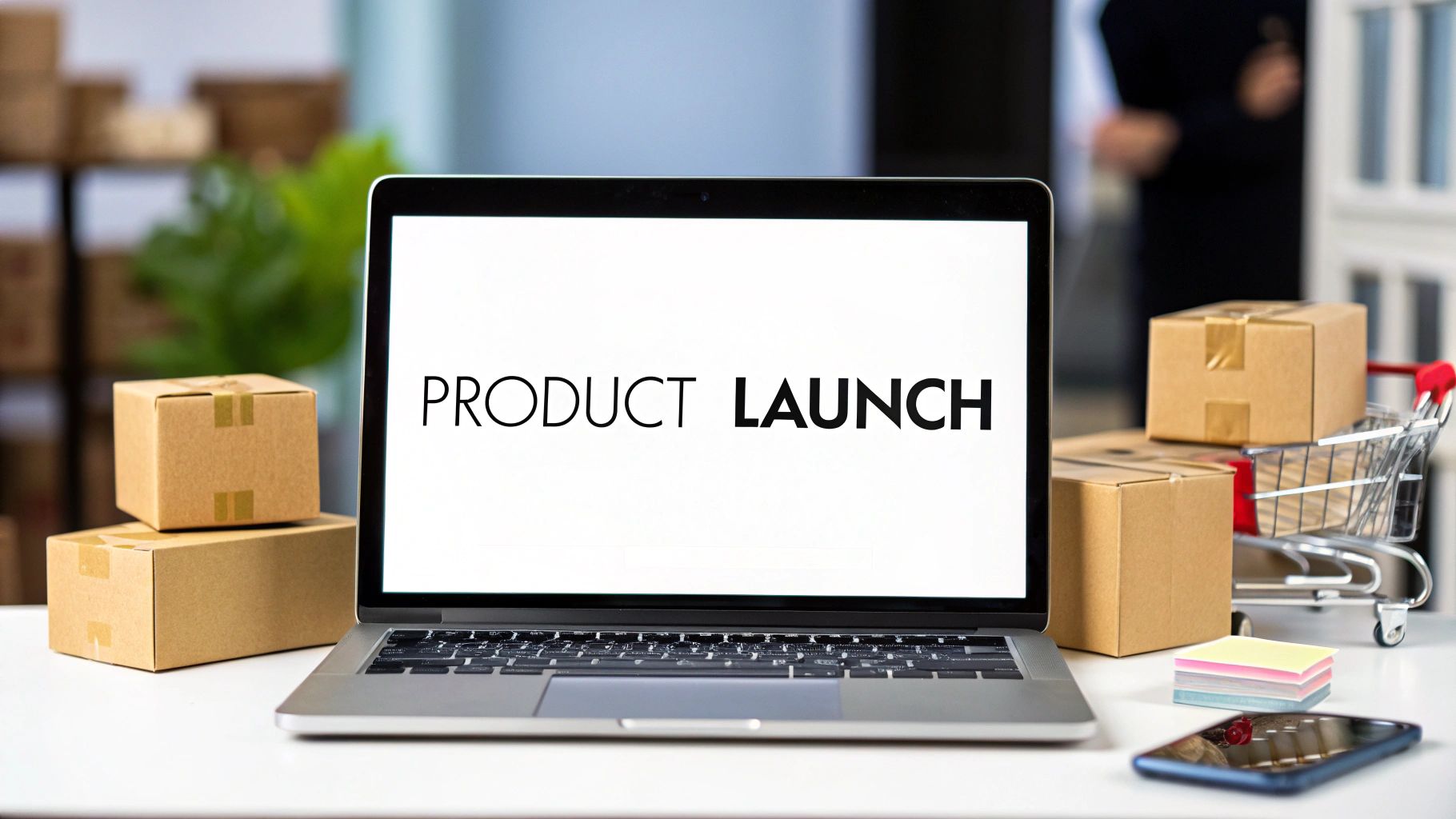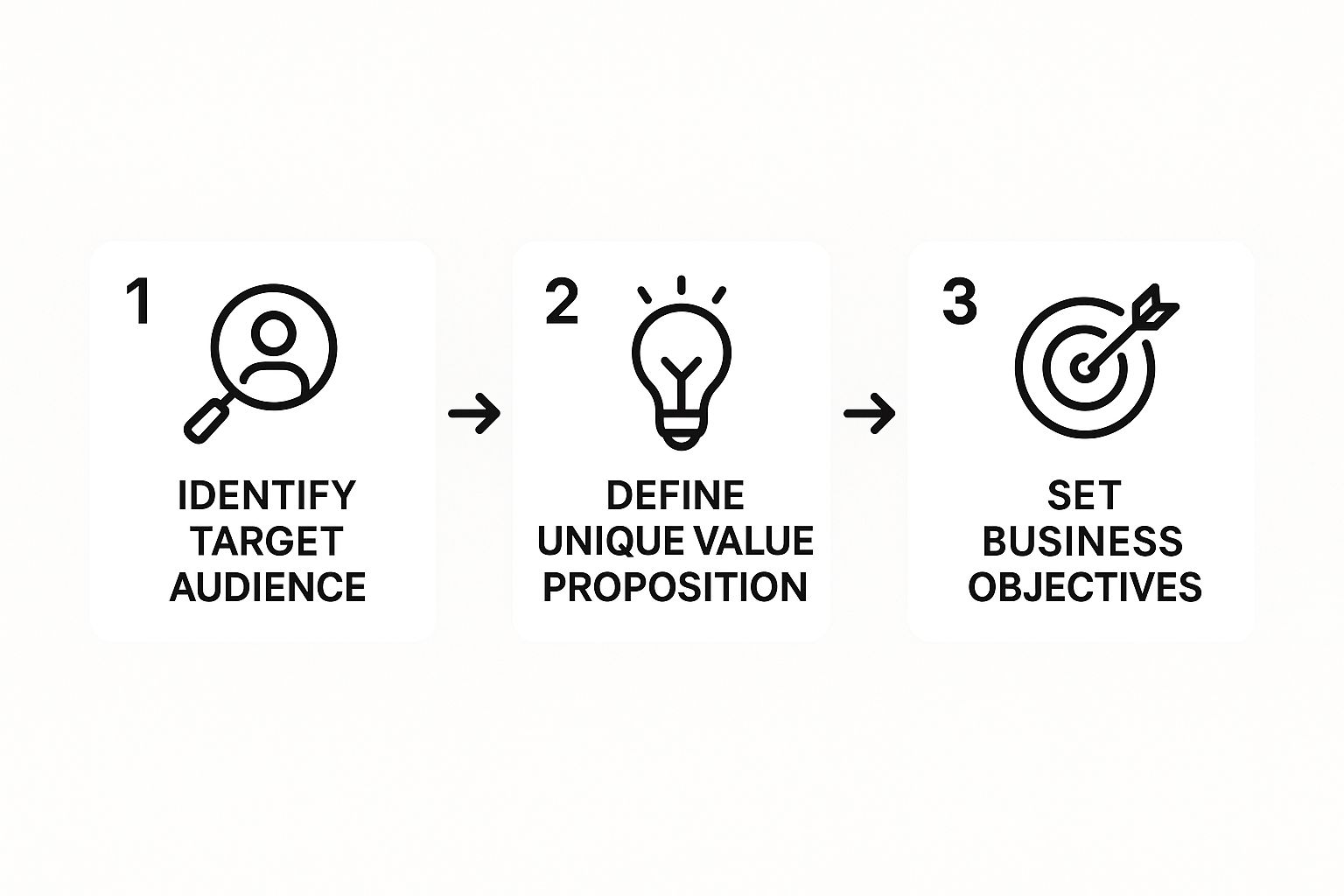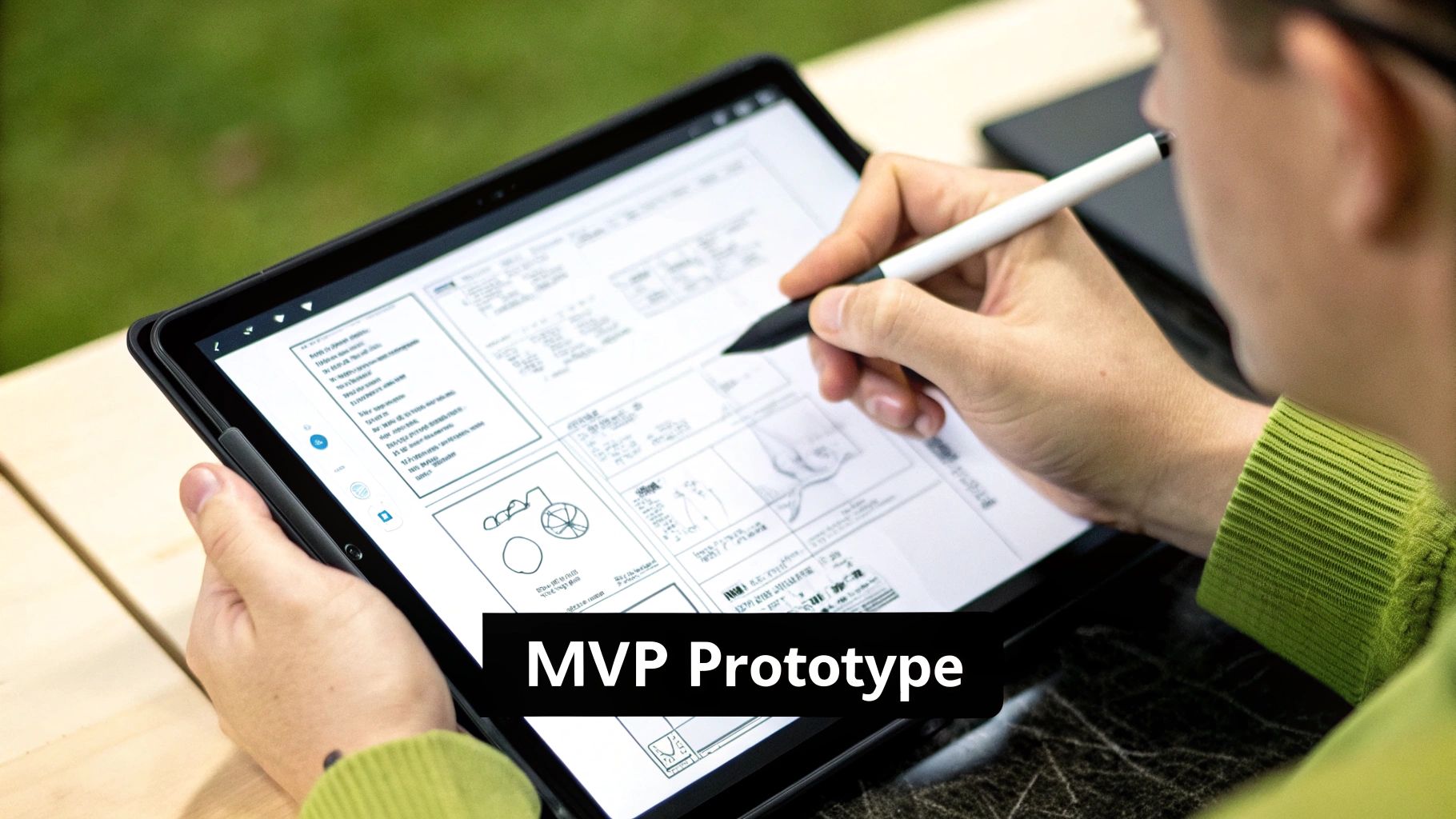Stay Updated with Everything about MDS
Thank you! Your submission has been received!
Oops! Something went wrong while submitting the form.

Chilat Doina
August 11, 2025
A great launch doesn't just happen. It’s the result of a deliberate, strategic foundation you build long before anyone even knows your product exists. This is where you get into the weeds of your market, figure out what makes your product a must-have, and set crystal-clear goals for what success actually looks like.
This pre-launch work is the bedrock of your entire go-to-market strategy.
Frankly, the fate of your product is often decided before a single customer clicks 'buy'. This is the critical period where you lay all the groundwork for a massive launch. If you rush this part or just phone it in, you're pretty much guaranteeing a lukewarm reception, which means wasted time, money, and momentum.
A vague audience like "millennial women" is a surefire way to get lost in the noise. You have to dig much, much deeper to create a hyper-specific customer persona. Think about their day-to-day frustrations, what really motivates them, and the exact words they use when they talk about their problems.
For instance, instead of targeting "fitness enthusiasts," get specific. Your ideal customer might be "Sarah, a 34-year-old working mom who needs quiet, at-home workout equipment she can easily hide in her small apartment." That level of detail changes everything—from your product features to the copy on your ads.
Studying your competition isn't about mimicking what they do. It’s about finding the holes in their strategy. Dive deep into their products, their customer reviews (the good, the bad, and the ugly), and how they market themselves. What are customers always complaining about? What problems are still unsolved?
Those gaps are your golden opportunities. If every competitor is selling a super-complex, feature-packed gadget, maybe your angle is a dead-simple, elegant solution that does one thing perfectly.
A successful product launch isn't just about what you do, but what your competitors aren't doing. Pinpoint their weaknesses and make them your strengths.
Your Unique Selling Proposition (USP) is your quick, punchy answer to the question: "Why should I buy from you and not the other guys?" It needs to be sharp, compelling, and laser-focused on a benefit that your specific customer actually cares about.
The second one is specific, solves a real problem, and instantly shows the value.
This is how these foundational pieces all lock together to form a solid strategy.

As you can see, it all starts with knowing your audience. That knowledge directly fuels the unique value you can offer and the business goals you're aiming to hit.
Vague goals like "have a successful launch" are useless. You need to set specific, measurable Key Performance Indicators (KPIs). For example:
Once you know your numbers, you can map out a detailed launch timeline. This isn't just a calendar with a few dates on it. It’s a full-blown project plan that assigns ownership, sets hard deadlines, and shows how everyone’s work connects.
A well-documented plan ensures the product team and marketing team are perfectly in sync and everyone knows what they’re responsible for. A great way to formalize this is by creating a proper https://milliondollarsellers.com/blog/ecommerce-business-plan to keep all your stakeholders on the same page. As you're building this foundation, it's also smart to follow a solid SEO checklist for new websites to give your product the best shot at ranking right out of the gate.

In a market this crowded, launching a product on a hunch is a recipe for disaster. I’ve seen it happen. The real difference between a launch that takes off and one that fizzles out is the quality of your intel.
This is where you stop guessing and start making calculated moves. We're talking about embedding AI and data analytics deep into your launch process. It's not about sounding fancy; it's about giving yourself a serious competitive edge.
AI can chew through massive amounts of data to flag emerging market trends long before they hit the mainstream. It’s like having a thousand analysts on your payroll, all working to figure out what customers will be clamoring for next.
By feeding your customer data into AI models, you can finally move past vague demographic buckets. Instead, you create razor-sharp segments based on what people actually do—their purchase history, their browsing habits, and even their predicted future needs. This lets you craft launch messaging that hits with incredible precision.
One of the biggest fears on launch day? Getting your inventory count completely wrong. You either sell out in an hour (and leave money on the table) or you're stuck with a warehouse full of product nobody wants. Data-driven demand forecasting is your best defense against this nightmare.
By crunching historical sales data, market trends, and even social media chatter, AI tools can produce surprisingly accurate sales projections.
This data also fuels a much smarter pricing strategy. Instead of picking a price and crossing your fingers, you can test different price points on specific audiences or even adjust prices on the fly based on demand, what your competitors are doing, and how much stock you have left.
For instance, a brand launching a new smart watch could use AI to monitor pre-order velocity and online buzz. If pre-orders are through the roof and everyone's talking about it, the system might suggest a small price bump after the initial launch to capitalize on the hype without killing momentum.
Trying to gather and analyze customer feedback during a chaotic launch is tough. AI-powered tools can handle the entire process. They’ll monitor social media mentions, review sites, and customer service chats, using sentiment analysis to instantly sort feedback into positive, negative, or neutral piles.
This gives you a live dashboard of customer sentiment. Imagine spotting a recurring complaint about a minor bug within hours of launching, not weeks later. That kind of speed lets you iterate quickly and shows your customers you're actually listening, which builds incredible brand loyalty.
The real magic of AI in a product launch is creating smarter, faster feedback loops. You accelerate your learning cycle, letting you adapt to customer needs at a pace your competitors simply can't match.
There's a reason AI's role in product management is exploding. It delivers smarter insights, which is why 76% of product leaders plan to pump more money into AI by 2025. It helps companies zero in on revenue and market differentiation instead of just shipping features. To see more on this, check out the latest product management trends at Airtable.com.
Ultimately, data and AI are about finding your opening. By analyzing the entire market, you can spot underserved niches or find the weak spots in what established players are offering. Maybe the data shows a growing frustration with overly complicated products, creating a perfect opportunity for a simpler, more intuitive alternative.
This kind of data-backed intelligence gives you the confidence to be a disruptor. Instead of going head-to-head with the market giants, you can carve out your own defensible space where your product is the no-brainer choice for a very specific, well-understood customer.
Here are a few ways to put this into practice:
When you weave these data-driven tactics into your plan, launching a new product stops being a shot in the dark and becomes a strategic execution built for success.

A fantastic product is practically invisible if you don’t have a great story to tell. Your go-to-market (GTM) content plan is how you’ll build that story, piece by piece, turning quiet interest into genuine excitement for what's coming. This is the playbook that dictates how you’ll grab attention and guide potential customers all the way to checkout.
The goal isn't just to rattle off a list of features; it's to create a compelling narrative that actually solves a real problem for your audience. That means you need to think bigger than a single announcement post. You’re building an entire ecosystem of content that works together to create hype and, ultimately, drive sales.
Before you write a single blog post or film a single video, you need a core product narrative. This is the central story you'll tell across every single channel. Keep it simple, powerful, and tie it directly back to the customer pain points you uncovered in your research.
Think of it this way: your product is the hero, and your customer’s problem is the villain. Your narrative simply explains how the hero wins.
For a brand launching a new portable blender, the story isn't "It has a 20,000 RPM motor." It's "Finally, you can make silky-smooth protein shakes at the gym, right after your workout, with a blender that's as powerful as it is portable." See the difference?
Your narrative has to focus on the transformation your product provides. Don't sell the mattress; sell a better night's sleep. This shift from features to benefits is the absolute key to creating content that connects.
A successful launch can't hang its hat on just one type of content. You need a solid mix of assets that serve different purposes and meet customers on the platforms they actually use. This multi-channel approach is how you make sure your message reaches the widest possible audience.
Your content arsenal should be packed with different formats to engage customers at every stage of their journey:
To help you decide where to focus your efforts, here's a look at how different channels can impact your launch.
A diverse content mix creates a web of touchpoints, guiding users from just browsing to actively wanting your product. The data backs this up—marketers consistently see massive lifts in awareness and conversions when they vary their content.
Email is still one of the most powerful tools for a product launch. It’s your direct line to your most interested prospects, and a well-designed email sequence can walk them from initial curiosity straight to being a launch-day buyer.
Think of your email sequence as a mini-story that unfolds over time:
By planning your content this carefully, you create a cohesive and persuasive experience that surrounds your customer with value. This strategy isn't just for a single launch; it’s a foundational part of bigger growth. Understanding different business expansion strategies can help you see how a successful launch fits into your long-term vision.
Well, the big day is finally here. All that planning, the content creation, the hype—it all comes down to this moment. Honestly, launch day isn't about some grand, last-minute strategy. It’s all about disciplined execution and being able to react—fast. Your job is to monitor everything, engage with your new customers, and put out any fires before they can spread.
Think of yourself as the mission control commander. Everyone on your team needs to know exactly what they're responsible for, have their dashboards open, and be ready to communicate on a dime.
Before you even think about hitting that "publish" button, a final technical sweep is absolutely non-negotiable. This is the worst possible time to find out your payment gateway is on the fritz or that your main call-to-action leads to a 404 error. This last-minute audit is what ensures all your hard work gets the flawless debut it deserves.
Your pre-flight check should absolutely include these things:
Once you’ve ticked off these boxes, you're ready to coordinate the official "go-live." This means publishing your product page, adding it to your website's navigation, and pushing all your pre-written announcements live simultaneously.
A smooth launch isn't about everything going perfectly—it's about having a plan to handle the inevitable imperfections. Your real goal is to be so prepared that you can solve problems before most customers even notice them.
The second your launch is live, your communication plan kicks into high gear. This is where you shift from talking at your audience to talking with them. Those first few hours are absolutely critical for building momentum and getting that all-important social proof.
Your plan needs to be a two-way street. First, fire off that announcement email to your subscriber list. This will almost certainly be your biggest single driver of initial traffic. At the same time, get your launch posts up across all your social media channels.
But don't just post and walk away. Monitor social media mentions, comments, and DMs obsessively. Respond to every single question. Thank people for their support. When someone shares a screenshot of their order confirmation, celebrate it! This kind of real-time engagement shows there's a real, passionate team behind the product, which builds massive trust.
With the launch underway, your focus now shifts to the data. You need a clear, real-time view of what's happening. In these first few hours, there are a few key metrics you need to have your eyes glued to:
Even with the most meticulous planning, things go wrong. A common one I've seen is a payment processor flagging a sudden surge of transactions as fraudulent. Have the direct support line for your payment gateway handy. Likewise, if your site slows to a crawl from a traffic spike, know how to contact your hosting provider immediately.
Having these contingency plans ready turns a potential disaster into a minor speed bump.

A killer launch day is just that—one day. It's the starting line, not the finish. The real work begins now, turning that initial burst of excitement into lasting, sustainable growth. These next few days and weeks are where you prove your product's worth and transform those first buyers into genuine brand fans.
Your first order of business? Listen. I mean really listen. That first wave of customers is your single most valuable source of raw, unfiltered feedback. They'll tell you exactly what’s working, what’s confusing, and what’s flat-out broken. Don't just wait for them to find you; go out and actively seek their opinions.
You need to open up simple, direct channels for customers to share their thoughts. This isn't just about catching bugs—it’s about getting a gut-level understanding of the user experience. You need a system to wrangle all this feedback so you can spot the patterns and prioritize what to tackle first.
Here are a few practical ways I’ve seen work wonders:
By funneling all this feedback into one place, you get a data-driven roadmap for your first round of product updates. This ensures you're spending time fixing the problems your customers actually care about.
Those first glowing customer experiences are pure marketing gold. You have to capture and amplify them immediately to build trust with prospects who are still kicking the tires. A bit of authentic praise from a real customer is infinitely more powerful than any ad you can run.
Your first happy customers are your most powerful marketing asset. Their genuine enthusiasm provides the social proof needed to convince the next wave of buyers.
Turn those early wins into compelling content. When someone leaves a great review, reach out and ask if you can feature their comment on your product page. Encourage them to share photos or videos of them using the product on social media with a unique hashtag. This user-generated content (UGC) feels real and starts to build a community around your brand. To really keep the momentum going, start thinking about implementing effective ecommerce growth strategies.
Alright, time to get critical with your launch day numbers. Look past the top-line revenue and dig into the data to see what really moved the needle. Did your email list blow your social media ads out of the water? Did that one influencer you took a chance on drive a shocking amount of traffic?
This is where you unearth your biggest opportunities. If you see your paid ads had a high click-through rate but a low conversion rate, that’s a huge clue. It suggests your ad was great, but the landing page missed the mark. For more on this, we've got a whole guide on how to increase your ecommerce sales with practical advice.
The tools for this kind of analysis are getting seriously sophisticated. The global product launch software market is projected to jump from $3.44 billion in 2024 to $5.31 billion by 2029. This explosive growth shows a clear shift toward using data to fine-tune every part of a launch, from initial targeting to customer follow-up.
By truly understanding your data, you can start reallocating your marketing budget to the channels that are actually delivering, making every dollar you spend more effective and kickstarting a cycle of continuous growth.
Every product launch comes with its own set of tough questions. The smart move is to get clear, practical answers before you're in the thick of it. That way, you're not just reacting—you're executing a plan based on proven solutions.
This is the big one, the fear that keeps founders up at night: getting the inventory wrong. But you don't have to guess. The key is to think in tiers, not all at once.
Start with a conservative initial stock level. It should be just enough to satisfy your most eager early adopters without tying up all your capital or risking a mountain of unsold product.
For instance, if your best forecast is 1,000 units for the first month, don't order all 1,000. Start with 400 units ready to ship and have your supplier on standby to produce the next 600 with a quick turnaround. This approach minimizes your upfront financial exposure and lets you ramp up fast if demand blows past your expectations.
A slow start can feel like a punch to the gut, but it's rarely a sign of failure. It's just a data point. The absolute first thing to do is resist the urge to panic and start digging into your funnel.
Are people hitting your product page but not clicking "buy"? The problem might be your price, unexpected shipping costs, or maybe your messaging just isn't landing right.
If you're not even getting the traffic, then your marketing isn't hitting the mark. It's time to go back and look at your audience targeting and ad creative. Sometimes, all it takes is a simple tweak to your ad copy or a more compelling call-to-action to get the ball rolling.
Don't mistake a quiet launch for a failed product. Use the initial data to diagnose the real problem—it's usually a messaging or traffic issue, not a product one.
This is your golden opportunity to learn exactly what resonates with your customers before you pour more money into scaling your marketing.
At Million Dollar Sellers, we connect you with elite e-commerce founders who have navigated these challenges countless times. Join our exclusive community to access the strategies and peer support needed to turn any launch into a long-term success story. Learn more at https://milliondollarsellers.com.
Join the Ecom Entrepreneur Community for Vetted 7-9 Figure Ecommerce Founders
Learn MoreYou may also like:
Learn more about our special events!
Check Events